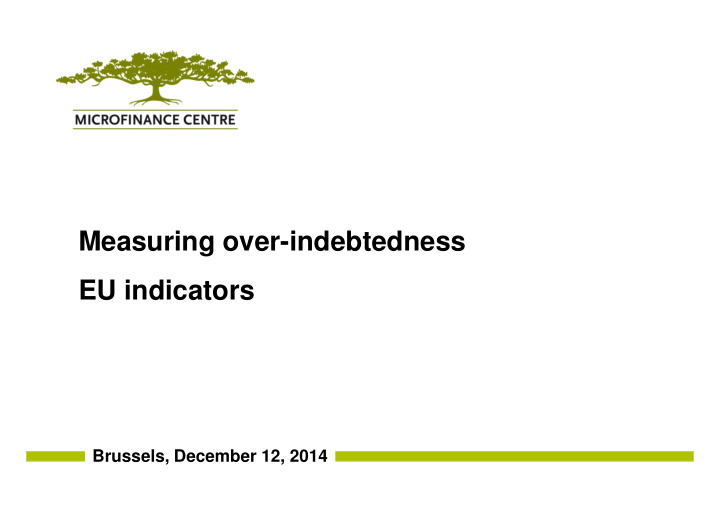



Measuring over-indebtedness Measuring over-indebtedness EU indicators Brussels, December 12, 2014
A lot of information available • Various institutions – Eurostat – European Central Bank – Eurobarometer – World Bank • Ad-hoc modules/regular data collection – Eurostat OID module in 2008 – Eurostat SILC indicators - annually – ECB Household Finance and Consumption Survey – bi-annually
A variety of indicators already collected • Macro-economic level and micro/household level – Gross household debt relative to income – Debt service to income ratio per household • • Objective/subjective measures Objective/subjective measures – Indicators of the amount of debt relative to income or assets – Perceptions of debt burden • Cross-sectional and longitudinal data – Multiple countries, data series
Map of indicators Eurostat World Bank Macroeconomic level Gross debt-to- Non-performing income ratio of loans households Eurostat ECB HFCS Eurobarometer SILC module Household-level Objective Presence of arrears Debt-to- disposable income or assets Subjective Debt burden At risk of over- indebtedness
Map of indicators Eurostat World Bank Macroeconomic level Gross debt-to- Non-performing income ratio of loans households Eurostat ECB HFCS Eurobarometer SILC module SILC module - arrears on mortgage or Household-level Objective Presence of arrears Debt-to- rent disposable - arrears on hire-purchase income or or other loans assets - arrears on utility bills Subjective Debt burden At risk of over- indebtedness
Map of indicators Eurostat World Bank Macroeconomic level Gross debt-to- Non-performing income ratio of loans households Eurostat ECB HFCS Eurobarometer SILC module Household-level Objective Presence of Debt-to- arrears disposable - financial burden of housing cost income or - financial burden of the repayment assets of debts from hire purchases or Subjective Debt burden At risk of over- loans indebtedness
Map of indicators Eurostat World Bank Macroeconomic level Gross debt-to- Non-performing income ratio of loans households Eurostat ECB HFCS - debt to income ratio Eurobarometer SILC module - debt service to income ratio Household-level Objective Presence of Debt-to-income arrears or assets - debt to asset ratio Subjective Debt burden At risk of over- indebtedness
Data limitations • Several databases, impossible to carry out in-depth analysis of all indicators • Some data cover only selected countries • Mixture of measures related to credit and non-credit commitments • Incomplete set of measures to assess credit-related over- indebtedness • Plenty of data, but only statistical analysis
Map of indicators Eurostat World Bank Macroeconomic level Gross debt-to- Non-performing income ratio of loans households Eurostat ECB HFCS Eurobarometer SILC module Household-level Objective Presence of Debt-to- arrears disposable income or assets Subjective Debt burden At risk of over- indebtedness
Data limitations • Several databases, impossible to carry out in-depth analysis of all indicators • Some data cover only selected countries • Mixture of measures related to credit and non-credit commitments • Incomplete set of measures to assess credit-related over- indebtedness • Plenty of data, but only statistical analysis
Data limitations Eurostat World Bank Macroeconomic level Gross debt-to- Non-performing income ratio of loans households Eurostat ECB HFCS Eurobarometer SILC module only Euro area Household-level Objective Presence of Debt-to- countries arrears disposable income or assets Subjective Debt burden At risk of over- indebtedness
Data limitations • Several databases, impossible to carry out in-depth analysis of all indicators • Some data cover only selected countries • Mixture of measures related to credit and non-credit commitments • Incomplete set of measures to assess credit-related over- indebtedness • Plenty of data, but only statistical analysis
Data limitations Eurostat World Bank Macroeconomic level Gross debt-to- Non-performing income ratio of loans households - arrears on mortgage or rent Eurostat ECB HFCS Eurobarometer SILC module - arrears on hire-purchase or other loans Household-level Objective Presence of Debt-to- - arrears on utility bills arrears disposable income or assets - financial burden of housing cost Subjective Debt burden At risk of over- - financial burden of the repayment indebtedness of debts from hire purchases or loans
Data limitations • Several databases, impossible to carry out in-depth analysis of all indicators • Some data cover only selected countries • Mixture of measures related to credit and non-credit commitments • Incomplete set of measures to assess credit-related over- indebtedness • Plenty of data, but only statistical analysis
Data limitations Eurostat World Bank Macroeconomic level Gross debt-to- Non-performing income ratio of loans households Eurostat ECB HFCS Eurobarometer - arrears on mortgage or SILC module rent Household- Objective Presence of Debt-to- - arrears on hire-purchase level arrears disposable or other loans income or assets - arrears on utility bills Subjective Debt burden At risk of over- indebtedness
Data limitations • Several databases, impossible to carry out in-depth analysis of all indicators • Some data cover only selected countries • Mixture of measures related to credit and non-credit commitments • Incomplete set of measures to assess credit-related over- indebtedness • Plenty of data, but only statistical analysis
Ways forward • Separate credit-related measures from unpaid dues on other commitments (rent, bills) • Credit related measures: – add indicators on credit use (mortgage, hire purchase, consumer, business loans, credit/store card) business loans, credit/store card) – Add the indicator on all credit arrears - mortgage, hire-purchase and other loans – add indicator on financial debt burden of repayment of all credits - mortgage, hire purchase debts or other loans
Ways forward • Conduct more analysis, data mining of the existing data • Collect lead indicators through one data collection engine • Develop Debt Watch mechanism for monitoring over- indebtedness
Microfinance Centre Thank you! Thank you! ul. Noakowskiego 10/38 00-666 Warsaw, Poland Tel/fax.+48 22 622 34 65 microfinance@mfc.org.pl www.mfc.org.pl
Recommend
More recommend